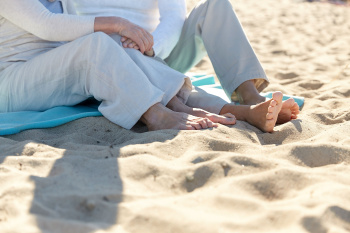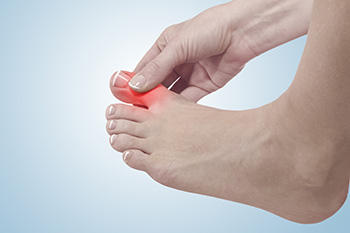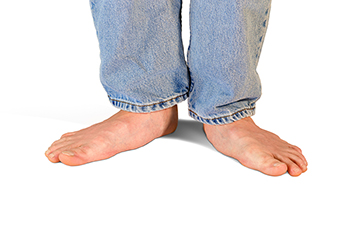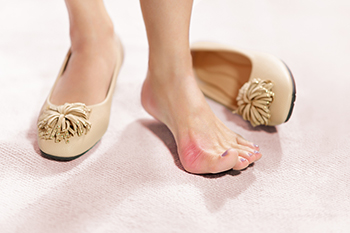Items filtered by date: July 2024
Summer-Ready Feet
 As summer is here, it is good to prepare your feet for the season to ensure they stay healthy and comfortable. Start by exfoliating regularly to remove dead skin, especially on the heels, keeping your feet smooth. Moisturize daily with a thick, hydrating lotion to prevent dryness and cracking. Trim your toenails straight across to avoid ingrown toenails and keep them at a comfortable length. Switch to breathable, well-fitted footwear to reduce the risk of blisters and fungal infections. Consider wearing sandals with good arch support to maintain foot health during outdoor activities. Apply sunscreen to your feet while wearing open-toed shoes to protect against harmful UV rays. Stay hydrated to maintain overall skin health and keep your feet cool and dry. If you engage in activities like hiking or running, ensure you wear appropriate shoes and socks to prevent injuries. For any foot-related concerns or persistent issues, it is suggested that you visit a chiropodist.
As summer is here, it is good to prepare your feet for the season to ensure they stay healthy and comfortable. Start by exfoliating regularly to remove dead skin, especially on the heels, keeping your feet smooth. Moisturize daily with a thick, hydrating lotion to prevent dryness and cracking. Trim your toenails straight across to avoid ingrown toenails and keep them at a comfortable length. Switch to breathable, well-fitted footwear to reduce the risk of blisters and fungal infections. Consider wearing sandals with good arch support to maintain foot health during outdoor activities. Apply sunscreen to your feet while wearing open-toed shoes to protect against harmful UV rays. Stay hydrated to maintain overall skin health and keep your feet cool and dry. If you engage in activities like hiking or running, ensure you wear appropriate shoes and socks to prevent injuries. For any foot-related concerns or persistent issues, it is suggested that you visit a chiropodist.
Summer is the season for many foot and ankle issues. If you’re suffering from a foot or ankle problem, please consult with one of the chiropodists from Complete Family Footcare & Therapy. Our clinicians can help you maintain the health of your lower limbs and your mobility.
Common Summer Foot Problems
Athlete’s foot
Toenail fungus
Plantar warts
Foot and ankle injuries
Bunions
Hammertoes
Heel pain
Cracked heels
Sunburns
Blisters
Prevention
Wear supportive shoes and avoid flip-flops
Maintain good foot hygiene
Exfoliate and moisturize the heels
Apply sunscreen to the feet and ankles
Wear shoes in public areas like swimming pools, locker rooms, and showers
If you have any questions, please feel free to contact our offices located in . We offer the newest diagnostic and treatment technologies for all your foot care needs.
Causes of Big Toe Pain
 Big toe pain can stem from various causes, affecting anyone from athletes to the elderly. Common reasons include gout, a form of arthritis caused by uric acid crystals accumulating in the joint, leading to severe pain and swelling. Another cause is bunions, a bony bump that forms at the joint base, often due to wearing ill-fitting shoes or a genetic predisposition. Turf toe, a sprain of the big toe joint from repetitive upward bending, and hallux rigidus, arthritis causing stiffness in the toe, are also frequent culprits. Big toe pain can feel sharp, throbbing, or aching, impacting mobility and daily activities. Prevention involves wearing proper footwear, maintaining a healthy weight, and avoiding activities that strain the toe excessively. Treatment depends on the cause but often includes rest, anti-inflammatory medications, and orthotics. If you are experiencing big toe pain, it is suggested that you schedule an appointment with a chiropodist for an individualized diagnosis and treatment plan.
Big toe pain can stem from various causes, affecting anyone from athletes to the elderly. Common reasons include gout, a form of arthritis caused by uric acid crystals accumulating in the joint, leading to severe pain and swelling. Another cause is bunions, a bony bump that forms at the joint base, often due to wearing ill-fitting shoes or a genetic predisposition. Turf toe, a sprain of the big toe joint from repetitive upward bending, and hallux rigidus, arthritis causing stiffness in the toe, are also frequent culprits. Big toe pain can feel sharp, throbbing, or aching, impacting mobility and daily activities. Prevention involves wearing proper footwear, maintaining a healthy weight, and avoiding activities that strain the toe excessively. Treatment depends on the cause but often includes rest, anti-inflammatory medications, and orthotics. If you are experiencing big toe pain, it is suggested that you schedule an appointment with a chiropodist for an individualized diagnosis and treatment plan.
Toe pain is common and can have a variety of causes. Causes can range from a broken toe to an ingrown toenail. Many types of toe pain can be corrected, but any toe pain that inhibits your activities for an extended period should be discussed with a chiropodist. If you suffer from toe pain, please consult with one of the chiropodists from Complete Family Footcare & Therapy. Our clinicians can help you maintain the health of your feet.
Common Causes of Toe Pain
- Trauma or fracture
- Cuts, sores, or bruises
- Rheumatoid arthritis
- Gout
- Turf Toe
- Morton’s neuroma
- Blisters
- Corns
- Bunions
- Hammertoes
- Ingrown toenails
- Plantar warts
- Athlete’s Foot
Symptoms of Toe Pain
- Toe deformity
- Burning
- Numbness
- Toenail deformity
- Wart or ulcer
- Swelling
- Redness
When to See a Chiropodist
- Bleeding or severe swelling
- Trauma, such as a broken bone
- Discoloration or extreme swelling
- Inability to bear weight
- Persistent pain
- Wounds that won’t heal
Diagnosis of Toe Pain
A chiropodist can conduct a thorough examination of the painful toe or toes in order to determine the best course of treatment. The exam may include assessing the tenderness of the area, taking an X-ray or other diagnostic test, or assessing your gait and range of motion. A discussion of what led to the advanced pain issue may follow. Included will likely be a health history, as well as a list of medications you are taking and other previous injuries you may have sustained.
Treatment for Toe Pain
With such a wide range of possible causes for toe pain, treatment can be varied in scope and length. Sometimes, the chiropodist will recommend lifestyle and activity changes. In cases of trauma or other injuries, X-rays or imaging tests will likely be used to determine the severity of the problem, particularly if any bones have been broken. Treatment may also include injections of pain-relief medication or anti-inflammatory drugs. Certain injuries will require the splinting, bracing, or wrapping of injured toes. Orthotics or special shoes may be prescribed in cases of bone deformities and gait issues. Removal of warts, calluses, and corns may be needed. In other cases, such as with patients who have diabetes or rheumatoid arthritis, ongoing treatment may be required to avoid more serious problems.
Causes and Diagnosis of Flat Feet

Flat feet, also known as fallen arches, is a condition where the arches of the feet collapse, causing the entire sole to touch the ground. This can be due to several factors, including weakened or torn tendons, broken bones, and ligament injuries. The posterior tibial tendon is particularly important in maintaining the arch, and when it is damaged, the arch can collapse. Broken bones in the feet can also disrupt the structural integrity of the arches. Additionally, ligament injuries can affect the stability and alignment of the foot, leading to flat feet. Diagnosis of flat feet involves a physical examination where a chiropodist observes the feet while standing and walking. Imaging tests such as X-rays and MRI scans may be used to further assess the condition of the bones and tendons, providing a comprehensive understanding of the underlying causes. If you have flat feet, it is suggested that you are under the care of a chiropodist who can help you to manage this condition, and guide you toward foot strengthening stretches.
Flat feet are a common foot condition. If you are experiencing pain or discomfort due to flat feet, please consult with one of the chiropodists from Complete Family Footcare & Therapy. Our clinicians will assess your condition and provide you with quality foot and ankle treatment.
What Are Flat Feet?
Flat feet are feet that do not have a well-defined arch in the middle of the sole of the foot. Flat feet may be flexible or rigid. Flexible flat feet have an arch when there is no pressure put on the foot, such as when one is sitting, but the arch disappears upon standing. Rigid flat feet lack an arch regardless of whether one is standing or not.
Causes
Flat feet can be present from birth or acquired over time due to a weakening of the ligaments in the arch. Sometimes flat feet are caused by illnesses, injuries, or pregnancy.
Symptoms
Flat feet often cause no noticeable symptoms. However, some people may experience pain and discomfort due to their flat feet.
Symptoms associated with flat feet include:
Pain in the arch, heel, ankle, or along the outside of the foot
Overpronation of the foot
Shin splints
Aching or fatigue in the feet or legs
Pain in the knees, hips, or lower back
Treatment
In cases where flat feet cause symptoms, there are various treatments available. Wearing orthotic inserts in your shoes to provide more arch support, performing stretches, and taking medications may improve your symptoms. If you are overweight, losing weight can help relieve pressure on the feet. In severe cases, surgery may be considered.
If you have any questions, please feel free to contact our offices located in . We offer the newest diagnostic and treatment technologies for all your foot care needs.
Bunions Can Interfere With Walking
 Bunions are bony bumps that form at the base of the big toe, causing the toe to deviate toward the others. They develop due to prolonged pressure on the joint, often from wearing tight or ill-fitting shoes. Genetics, arthritis, and foot injuries can also contribute to their formation. Symptoms include a visible bump, swelling, redness, and pain around the affected joint. Over time, bunions can lead to difficulty in walking, as they cause misalignment of the toes and increase pressure on the ball of the foot. This can result in discomfort, a limited range of motion, and changes in gait. Relief options include wearing wider shoes, using orthotic devices, and taking anti-inflammatory medications. In severe cases, surgery may be necessary to realign the bones. If you have persistent or worsening symptoms from your bunion, it is suggested that you visit a chiropodist for a comprehensive evaluation and a personalized treatment plan.
Bunions are bony bumps that form at the base of the big toe, causing the toe to deviate toward the others. They develop due to prolonged pressure on the joint, often from wearing tight or ill-fitting shoes. Genetics, arthritis, and foot injuries can also contribute to their formation. Symptoms include a visible bump, swelling, redness, and pain around the affected joint. Over time, bunions can lead to difficulty in walking, as they cause misalignment of the toes and increase pressure on the ball of the foot. This can result in discomfort, a limited range of motion, and changes in gait. Relief options include wearing wider shoes, using orthotic devices, and taking anti-inflammatory medications. In severe cases, surgery may be necessary to realign the bones. If you have persistent or worsening symptoms from your bunion, it is suggested that you visit a chiropodist for a comprehensive evaluation and a personalized treatment plan.
Bunions progressively worsen over time and may cause walking in your shoes to become difficult. To learn more about bunions, please consult with one of the chiropodists from Complete Family Footcare & Therapy. Our clinicians will assess your condition and provide you with quality foot and ankle treatment.
What Are Bunions?
A bunion is a bony bump that protrudes from the base of the big toe. Bunions are caused due to a misalignment of the first metatarsal. The characteristic bump of a bunion forms when the metatarsal shifts outwards from its proper position. Bunions develop slowly over time and progressively worsen without treatment. The skin over the bunion may develop calluses due to the friction from shoes. Eventually, a bunion can make walking uncomfortable or even painful. Bunions are one of the most common foot deformities and are especially common in women and older adults.
Symptoms
A bunion appears as a bulging bump on the outside of the base of the big toe.
The bunion may also:
Be swollen, red, or sore
Develop corns or calluses over it
Cause pain
Limit the big toe’s range of motion
Treatment
There are several different treatments available for bunions. Conservative treatment options include wearing shoes with a wider toe box, cushioning the bunion with a specialized pad, wearing shoe inserts, icing the bunion if it becomes inflamed, and taking medications to relieve pain. In more severe cases, more invasive procedures may be done. This may involve removing the swollen tissue around the bunion, straightening the big toe, realigning the bones at the front of the foot, or a combination of these procedures.
If you have any questions, please feel free to contact our offices located in . We offer the newest diagnostic and treatment technologies for all your foot care needs
Why Live with Pain and Numbness in Your Feet?
Symptoms and Causes of Gout

Gout, a form of inflammatory arthritis, is caused by the buildup of uric acid crystals in the joints, leading to intense pain and swelling. Gout often affects the feet, particularly the big toe. It can result from a diet high in purines, found in red meat, seafood, and alcoholic beverages. Obesity, and certain medical conditions like high blood pressure and diabetes are other contributing factors. Symptoms of gout typically include sudden, severe attacks of pain, redness, and tenderness in the affected joint, often occurring at night. The skin surrounding the toe joint may appear shiny and feel warm to the touch. Recurrent gout attacks can lead to chronic joint damage and the formation of tophi, which are hard deposits of uric acid crystals under the skin. Managing gout involves lifestyle changes such as dietary adjustments, maintaining a healthy weight, and staying hydrated, in addition to medications that reduce uric acid levels and inflammation. If you are experiencing toe pain from a flare-up of gout, it is suggested that you schedule an appointment with a chiropodist for an exam and appropriate treatment.
Gout is a painful form of arthritis that can affect anyone. Please consult with one of the chiropodists from Complete Family Footcare & Therapy. Our clinicians will assess your condition and provide you with quality foot and ankle treatment.
What Is Gout?
Gout is characterized by sudden, severe attacks of pain, redness, and tenderness in the joints. This type of arthritis is caused by a buildup of uric acid in the bloodstream. When uric acid crystallizes in a joint, often the joint of the big toe, it can bring about a gout attack.
Symptoms
Symptoms of gout include:
Sudden and severe pain
Swelling
Redness
Warmth
Joint stiffness
Joint deformity
Diagnosis
A chiropodist will ask questions about your personal and family medical history, followed by an examination of the affected joint. Laboratory tests and x-rays are sometimes ordered to determine if the inflammation is caused by something other than gout. A sample of fluid taken from your joint can show whether it contains uric acid.
Treatment
Prescription medications or injections are used to treat the pain, swelling, and inflammation. Patients with chronic gout can also use behavioral modifications such as diet, exercise, and decreased intake of alcohol to help minimize the frequency of gout attacks. Foods and beverages that are high in purines should be avoided since purines are converted in the body to uric acid. If left untreated, this painful condition can leave your joint permanently damaged and swollen.
If you have any questions, please feel free to contact our offices located in . We offer the newest diagnostic and treatment technologies for all your foot care needs.

